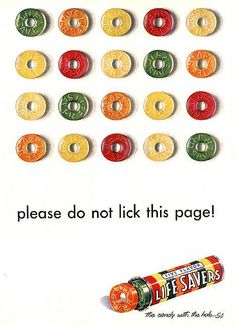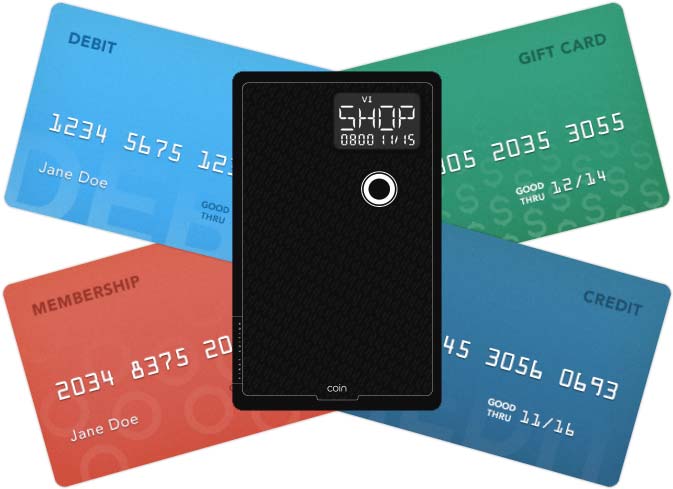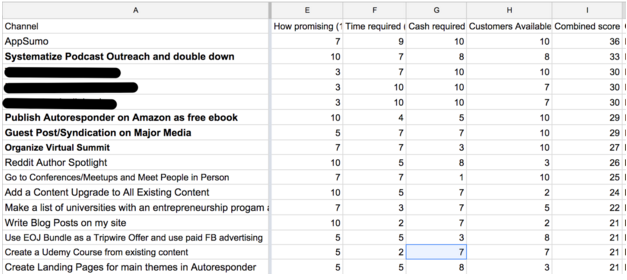Tl;dr: There are five marketing questions you must answer before you launch a marketing campaign: (I’ve put together a brief worksheet here).
One commonality I’ve noted when talking with, working with and observing successful investors is that they all have a checklist. It’s always very short, no more than half a dozen things. These questions whittle down at least 99% of deals they see so they spend the majority of their time on the 1%. Because there are hundreds of different factors to consider, a short, effect filter creates a huge advantage. I put one together for marketing campaigns.
Whenever I am about to launch or relaunch a product, this is a quick list of things to check down just like investors check down a shortlist. Going down the list doesn’t guarantee that the campaign will work spectacularly, but, at least for me, it has guaranteed some base level of success.
Who is my one starving customer?
Making a product for everyone is the same as making a product for no one. The nameless masses don’t exist. Every product is bought by a single individual. I pick a single individual that the product is for. It’s best if they are a real person I know (preferably myself), but if not then I have a detailed persona for them: What city do they live in? Do they live in a house or an apartment? How big? How is it decorated? How much money do they make? What do they do on the weekends? What are they most stressed out about right now? What are they most excited about right now?
There’s always push back to select a single individual because marketers conflate the target market with a total addressable market. “If I say it’s just for people that live in apartments then I alienate everyone that lives in houses.” Maybe, but probably not. Being hyper-targeted on a small segment of the market generally enhances your ability to reach a broader segment of the market. Here is the customer avatar I wrote for The End of Jobs:
“He’s 'on the fringe' of Entrepreneurship and sort of sees what’s going on. He’s young – under 35. Male. Interested in the promise of entrepreneurship from reading about it or seeing friends do entrepreneurial stuff, but doubtful about the truth behind it and/or the reality of it. Single. Lives in an apartment furnished on craigslist. Lives in the top 50 US cities. Angsty about the professional future. He has a 'good' job and doesn’t like the prospect of having his boss’s job in 3-5 years. He is working on a side business while being gnawed in the back of their head by his friend’s voice saying “What are you doing? get a real job!” and periodically thinking they are right.”
I would estimate that 99% of people that read the book don’t fit that profile. Women, people over 35, and people living outside the U.S. account for 80%+ of readers alone. However, having a profile that specific, made it very easy for me to make good decisions about how to position and marketing the book. It would have been more precisely “true” to say the market was much broader but it is always better to be roughly right than precisely wrong. The customer that I have had the most success in making things for is myself.
You may have heard this called scratching your itch, designing a product to solve a problem that you have. The avatar above was easy for me to write for because I had been him at one point in my life and I knew a lot of people that were him. If you’re not sure who the customer avatar should be, pick yourself. Once you know who they are, you want to make sure they are starving. Said another way, you want the itch to be itchy.
Copywriter Gary Halbert explained the importance of having a starving audience:
“'If you and I both owned a hamburger stand and we were in a contest to see who would sell the most hamburgers, what advantages would you most like to have on your side?' The answers vary. Some people say they would like to have the advantage of superior meat from which to make their hamburgers. Others say they want sesame seed buns. Others mention the location. Someone usually wants to be able to offer the lowest prices. And so on. Anyway, after my students are finished telling me what advantages they would most like to have I say to them: 'O.K., I’ll give you every single advantage you asked for. I, myself, only want one advantage and, if you will give it to me, I will whip the pants off of all of you when it comes to selling burgers!' 'What advantage do you want?' they ask. 'The only advantage I want,' I reply, 'is A STARVING CROWD!'”
If you pick a single individual and make sure they are starving (literally or metaphorically depending on what business you’re in), you almost can’t mess up. How will I reach them? What’s my channel?
I was talking with an entrepreneur a few weeks ago and he was trying to figure out which industry to start selling a B2B SaaS product he is developing. He has a really strong background in automotive but felt like it wasn’t the right place to start. What I think he was underestimating was that it takes years to build competence and relationships in an industry. Starting with a good but not perfect industry that you are already embedded in is a much better strategy than starting in the “perfect” industry that you don’t understand.
The “perfect” industry often looks that way because you don’t understand it. No one sees warts from a mile away. I see people make the same mistake with channel strategy. They try to pick the perfect objective channel instead of picking the best channel for them. It is really hard to get good at a single channel. I’ve been at this marketing game for a while and I’ve only got two channels that I’m good at.
Why them and not the prospects? The typical assumption is that it is hard to “build the widget” and easy to “reach the market.” However there is a strong trend in the opposite direction. Since Ford’s assembly line, production has gotten easier while distribution has gotten harder. So, the first question to ask is “What Existing Channels Do I Have Already?” If you have a channel you’re already competent at, you can use the cash flow and customer intelligence gained from that to start expanding. Is SEO the perfect channel for every business? No, but it (or any other channel) can probably get you to 100 customers at which point you’ll have a lot more intelligence to figure out what the better options are than you do now. If you don’t have access to a channel, you want to do an expected value calculation which consists of three steps.
Step 1: Brainstorm all the possible channels strategies – Be specific
Step 2: Grade them on four criteria:
1.How promising/likely to work is it?
2.How excited am I about it?
3.How much time will it take?
4.How much cash will it take?
5.How many customers are available?
In theory, you want a channel that is highly likely to work, that you are excited about, that will take very little time or cash and yield a lot of customers. In practice, these never exist but some are still better than others. Step 3: Test the top three. Repeat based on new data.
Note: This is based on Bullseye Framework in Justin Mares and Gabriel Weinberg’s Traction. You can download the first three chapters on their site: tractionbook.com/. I recommend you do so. Am I selling Aspirin, not Vitamins? (AKA What is their Biggest Pain Point?)
Marketing cannot create a desire for a product. It can only take existing hopes, dreams, fears, and desires and focus them onto a particular product. Once you know who you are selling to and how you are going to reach them, it’s time to figure out what their pain point is.
Why focus on the pain point and not the product’s benefits? Loss Aversion. Humans have a psychological bias called loss aversion. To quote me from Speed of Implementation and The Law of Shitty Click-Throughs, on loss aversion: “The best way to understand loss aversion is to imagine someone offering you a 50/50 gamble. You will flip a coin and heads you win, tails you lose.
There’s a catch. The minimum bet is $5,000. What’s the lowest payout you could tolerate, to place the bet? Would you take slightly better than equal odds? Heads you win $6,000 and tails you lose $5,000? Or would the payout have to be better? If the deal is heads you win $10,000 and tails you lose $5,000, would you do it?
In several experiments, researchers found participants usually would not participate for less than 2-2.5x; that is you have at least a 50% chance of losing $5,000 and winning $10,000.3This is irrational, so why do we do it? It’s a part of our evolutionary heritage. In a life or death situation, you should be risk-averse. If you are walking through the African Savannah and you hear a rustle in the bush and you estimate there is a 95% chance it is a delicious piece of food to eat for dinner and a 5% chance it is a lion, your ancestors ran away. The ones who didn’t were eventually weeded out of the gene pool and became a snack food.”
Always Sell Aspirin
Given that humans weigh losses 2-2.5x heavier, it is 2-2.5 times easier to sell aspirin than it is to sell vitamins. It is easier to sell relief than it is to sell prevention. All products can be sold as either aspirin or vitamins: Take coffee as an example.
Coffee provides a benefit by allowing you to be more alert in a meeting with a client. This is nice, but not essential. In this sense, coffee is a “vitamin.” it improves your life, but you can live without it. But imagine you’re going into a meeting, and you’re extremely tired. There’s a good chance you’ll fall asleep and lose the client. In this case, coffee is “aspirin,” –without it –you’ll be in a lot of trouble. Even vitamins can be sold as aspirin.
Vitamins can keep you healthy (vitamin) or prevent cardiovascular disease from clogging your arteries (aspirin). Always choose aspirin. I like to make a list of all the possible aspirin-like reasons that my one customer would have for buying the product then decide which is most painful.
The best place to get these ideas from is your customers. I often dig through old surveys or recorded call transcripts and find gold. How much do they know about my product? What is their State of Awareness? Every market has five different states of awareness and these states of awareness affect the way the product is marketed.
1. The Most Aware The customers know of your product-knows what it does-knows he wants it. The marketing simply states the name of the product and the price, that’s it. I went into Walgreens to buy allergy medicine a few weeks ago and I knew exactly what I wanted, I bought the first thing that had the right formula.
2. The Customer Knows Your Product but Doesn’t Want It Yet This is the bulk of traditional brand advertising. The main purpose of the ad is to reinforce the product’s superiority through visualization, documentation, and mechanisms. Life-Savers please don’t lick this page is the most famous example.

This type of advertising works but it requires both enormous scale and incredibly long cash conversion cycles. Someone that buys lifesavers whenever they are standing in line at the grocery store at age 50 do so because they’ve seen Lifesavers ads since they were five years old and have a deep association with the brand.
3. Introduce New Products The prospect knows or recognizes immediately that he wants what the product does, but doesn’t yet know that there is a product that will do it for him. The problem is two-fold,
- to pinpoint the ill-defined as yet uncrystallized desire and
- to crystallize that desire and its solution so sharply and dramatically that every prospect will recognize it at a glance.
The three steps to solving the problem are:
- Name the desire and/or its solution in your headline (use aspirin not vitamins)
- Prove that a solution is in reach
- Show that the solution is contained in your product.
A recent category that emerged and did this well was “mid-market” email service providers (ESPs). ESPs are services that let companies or individuals email in bulk to their customers and prospects. Previously, there were two categories of ESPs for small businesses –the basic, no-frills low-end (E.g. Mailchimp, Aweber) and more upmarket bundled services (E.g. Infusionsoft and Ontraport) that let companies do more segmentation, tagging, and automation but also included shopping carts, CRMs and other solutions that not everyone needed.
Companies like ActiveCampaign, Drip, and ConvertKit came in and said “Just like infusionsoft but less confusing and just email.” As soon as I heard that, I wanted it. Once they showed the market that they could deliver on that, all three took off.
4. How to Introduce Products that Addresses Needs The prospective customer has a need, not a desire, but doesn’t realize the connection between that need and your product. This requires the same three-step formula as above, but will often require more persuasion and longer timelines. I already knew what I wanted in an ESP, so it was an easy sell.
However, some people have needs that they don’t know there are solutions for. Take, for example, a hormone clinic. They have two distinct markets that they are serving: men need testosterone and women need estrogen. They want these solutions for different reasons and so need different marketing messages for each segment. They have a need that is solved by the product (via segmentation) but doesn’t immediately recognize that the solutions to their problem are an ESP.
5. How to Open Up a Completely Unaware Market The prospective customer is not aware of his desire/need or won’t admit it. It’s so amorphous and general that it can’t be summed up in a headline. There are not any formulas for this, but you must avoid all the angles from other states of awareness with which the market has already been barraged. This is the most difficult state of awareness for marketers but also the most profitable.
I was talking to a friend who read me an email he had written in 2010 trying to convince his friends to join Facebook: “It’s great for keeping up with your friends after college” was his selling point. This is true, but vastly understates all the use cases of Facebook. Explaining a social network, or any technology, to someone who has never been exposed is hard. Think about trying to explain a smartphone to someone without one: “It’s like a computer in your pocket” – “But I already have a computer in my bag? Why do I need one in my pocket?”
It’s worth noting that product categories and brands move through these states over time. Stage 5 is where startups and hi-tech tends to tend to thrive, SMBs and direct response marketing does well in stages 3 and 4. Larger organizations and brand marketers do well in stage 1 and 2.
At one point, Mercedes was a startup trying to explain to people that a Mercedes was like a “luxurious motorized carriage.” With every brand and product launch, you will have to re-evaluate your one starving customer’s State of Awareness. How many similar products have they been told about before? What is the level of Market Sophistication?
1. You are the first in your market Be simple, be direct, don’t be fancy. State the Solution to the desire simply and dramatize it in the rest of the marketing. For a brand new magic product, you don’t have to get fancy. You just have to say what you did. Coin a digital card in which you can save all your credit, debit, gift, and membership cards so you only have to carry one around.

Great, that’s all I need. I get it. I want it. The classic example is when diet pills were first introduced, the most successful headline was simply: “Now! Lose Ugly Fat!” Everyone already wanted to lose fat and now there was a pill that could do it. Say no more.
2. You are the second in the market Copy the successful claim but dramatize it. If you can dramatize well, you don’t have to be first to market. Chevy beat Tesla to market with the first fully electric car. The Chevy Bolt will come out a year or two before the Tesla, but it’s hard to see Chevy winning. Knowing nothing about cars or electric battery technology, which one of these is cooler and more dramatic?
Yeah, case closed. With diet pills, “Now! Lose Ugly Fat!” became “Lose up to 47 pounds in 4 weeks or receive $40 back.” Same essential promise but dramatize using specificity and a guarantee.
3. The Third Stage of Sophistication Your prospects have heard the claims and all the dramatizations have been taken to the very edge of believability. The desire (say to lose weight) has not faded and the dissatisfaction continues to build, they want a new way to satisfy an age-old desire. Here the emphasis shifts from what the product does to how it works. Not accomplishment but performance becomes the dominant aspect. “Lose up to 47 pounds in 4 weeks or receive $40 back.” becomes “FLOATS FAT RIGHT OUT OF YOUR BODY!” with a detailed explanation of how a pill “floats” fat.
4. How To Revive a Dead Product Your market no longer believes in your advertising. The emphasis shifts from the promise and the mechanism to identification with the prospect himself. The classic example is when cigarette companies started using visual ads of cowboys to reinforce the masculinity of the product or picked a new market by targeting women. The smart marketer knows that when a product is in this stage, it is time to get a new product (or a new market).
In Summary: Who is your one starving customer? How will you reach them? What’s your channel? Are you selling Aspirin, not Vitamins? (AKA What is their Biggest Pain Point? )How much do they know about your product? What is their State of Awareness? How many similar products have they been told about before? What is the level of Market Sophistication? I’ve put together a brief worksheet here.


